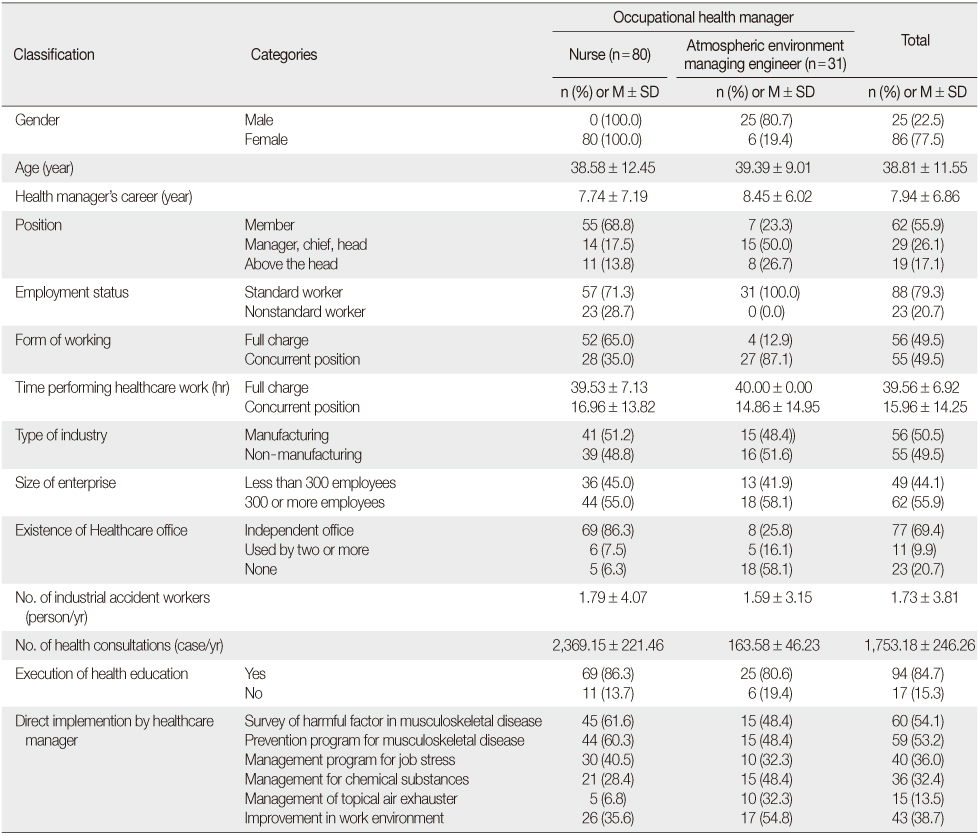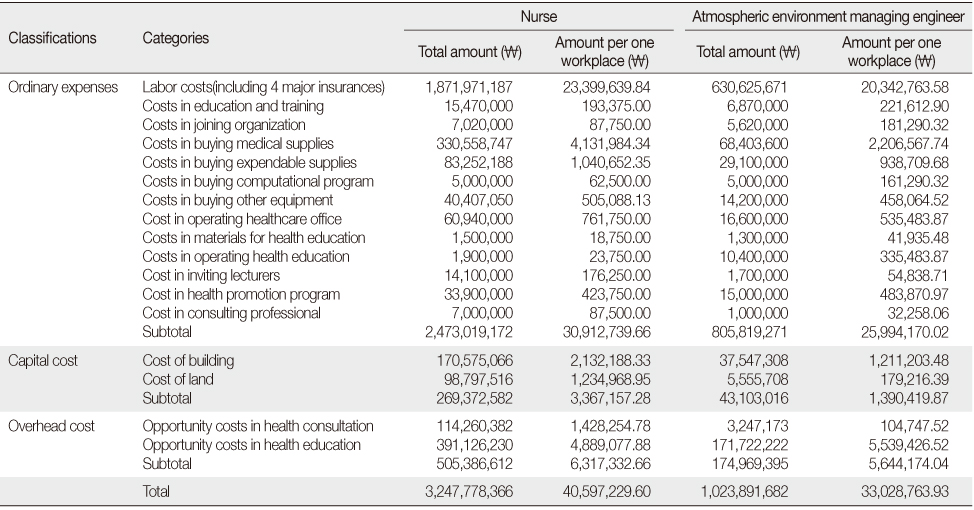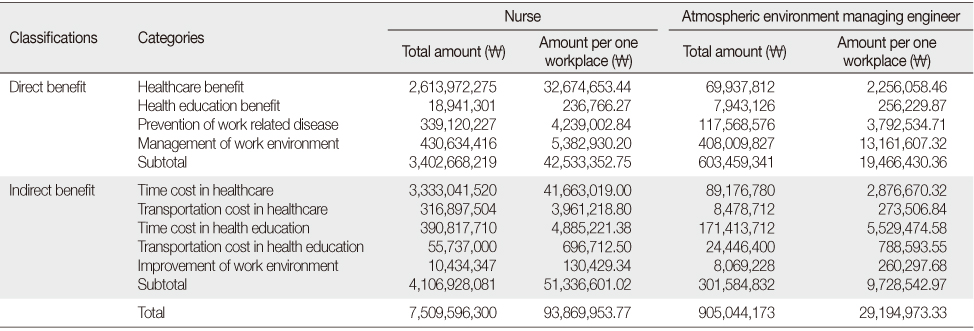Articles
- Page Path
- HOME > J Korean Acad Nurs > Volume 43(4); 2013 > Article
-
Original Article
- Economic Evaluation of a Workplace Occupational Health Nursing Service: Based on Comparison with Atmospheric Environment Managing Engineer
- Hye-Sun Jung, Bokim Lee
-
Journal of Korean Academy of Nursing 2013;43(4):507-516.
DOI: https://doi.org/10.4040/jkan.2013.43.4.507
Published online: August 30, 2013
1School of Medicine, The Catholic University of Korea, Seoul, Korea.
2Department of Nursing, College of Medicine, University of Ulsan, Ulsan, Korea.
- Address reprint requests to: Lee, Bokim. College of Nursing, University of Ulsan, 93 Daehak-ro, Nam-gu, Ulsan 680-749, Korea. Tel: +82-52-259-1283, Fax: +82-52-259-1236, bokimlee@ulsan.ac.kr
• Received: October 8, 2012 • Accepted: June 14, 2013
© 2013 Korean Society of Nursing Science
- 580 Views
- 5 Download
- 3 Crossref
Abstract
-
Purpose
- The purpose of this study was to use cost-benefit analysis of activity to clarify the economic effect of prepared nurses versus atmospheric environment managing engineers as healthcare managers.
-
Methods
- For the study 111 workplaces were surveyed, workplaces in which nurses or atmospheric environment managing engineers were employed as healthcare managers. The survey content included annual gross salaries, participation in external job training, costs in joining association covered by the company, location and year of construction of the healthcare office, various kinds of healthcare expenditures, costs in operating healthcare office, health education, and activity performance in the work of environment management.
-
Results
- In the case of the healthcare manager being a nurse, benefit was larger than input costs at a ratio of 2.31. On the other hand, in the case of healthcare manager being an atmospheric environment managing engineer, input costs were larger than benefits (benefit-cost ratio 0.88).
-
Conclusion
- Results indicate that nurses are an effective healthcare human resource and can offer good quality healthcare service. Therefore companies should hire nurses and actively promote the economic efficiency of nurses in workplace.
- 1. Brent RJ. Applied cost-benefit analysis. 2nd ed. Cheltenham, UK: Edward Elgar Publishing Ltd; 2007.
- 2. Chang SR, Kim DJ, Park JY, Kim JW. Economical effect analysis of musculoskeletal burdened work improvement. In: Fall Conference and General Meeting Ergonomics Society of Korea; Busan. 2007.
- 3. Chenoweth D, Martin N, Pankowski J, Raymond LW. A benefit-cost analysis of a worksite nurse practitioner program: First impressions. J Occup Environ Med. 2005;47(11):1110–1116.ArticlePubMed
- 4. Chenoweth DH, Garrett J. Cost-effectiveness analysis of a worksite clinic: Is it worth the cost? AAOHN J. 2006;54(2):84–89.ArticlePubMedPDF
- 5. Childre F. Nurse managed occupational health services: A primary care model in practice. AAOHN J. 1997;45(10):484–490.PubMed
- 6. Cromley EK, McLafferty SL. GIS and public health. 2nd ed. New York, NY: Guilford Press; 2012.
- 7. Davidson G, Widtfeldt A, Bey J. On-site occupational health nursing services: Estimating the net savings: Part II. AAOHN J. 1992;40(5):242–249.
- 8. Hong YC, Ha EH, Jun KJ, Rho YM, Park HS, Jo HS, et al. Job performance of occupational health personnel. Korean J Occup Environ Med. 1997;9(3):496–507.ArticlePDF
- 9. Hu SI, Kim MG, Lee SH, Kim SJ. Policy options to tackle unmet health needs. Seoul: Korea Institute for Health and Social Affairs; 2009.
- 10. Human Resources Development Service of Korea. Environmental air pollution industrial engineer. 2011;Retrieved August 8, 2011. from http://www.q-net.or.kr/crf005.do?id=crf00503s01&gSite=Q&gId=07&jmCd=2571&jmInfoDivCcd=A
- 11. Im GJ, Choi JW, Lim SM, Seo KH, Park YH. A survey of the medical practitioners' offices in Korea 2011. J Korean Med Assoc. 2012;55(4):390–403. http://dx.doi.org/http://dx.doi.org/10.5124/jkma.2012.55.4.390Article
- 12. Jung HS, Kim HR, Roh YM, Lee YJ, Lee BI, Jhang WG, et al. The study for status and burden according to compulsory employment of occupational health personnel in the middle size enterprises dealing chemical materials. Incheon: Occupational Safety and Health Research Institute; 2008.
- 13. Jung HS, Kim YK, Lee BI, Yun KJ, Hwang GS. A study for refining the qualification and industry for compulsory employment of occupational health personnel. Gwacheon: Ministry of Employment and Labor; 2010.
- 14. Kim HY, Jang SH. Study for rationalizing the appointment and qualification standards for safety and health manager. Incheon: Occupational Safety and Health Research Institute; 2011.
- 15. Kim YI, Cho TR, Chun KJ, Jeong HS. A survey of the working condition for occupational health nurses. Korean J Occup Health Nurs. 1996;5:73–89.
- 16. Kim YI, Kim SL, Kim HG, Lee JE, Kim YH. Working conditions of occupational health nurses in Korea. Korean J Occup Health Nurs. 2007;16(2):130–138.
- 17. Ko YK. The relationships among waiting time, patient's satisfaction, and revisiting intention of outpatients in general hospital. J Korean Acad Nurs Adm. 2010;16(3):219–228. http://dx.doi.org/http://dx.doi.org/10.11111/jkana.2010.16.3.219Article
- 18. Korean Appraisal Board. Casebook of standard appraisal report. Seoul: Author; 2008.
- 19. Lee JH, Roh JH, Kim KS, Ahn YS. A study on the practical behavior of health care managers at the worksite. Korean J Occup Environ Med. 1995;7(1):88–100.ArticlePDF
- 20. Lee SY. A study on the working conditions of occupational health nurses and the factors for job satisfaction. Incheon, Incheon University. 2008;Unpublished master's thesis.
- 21. Luce BR, Simpson K. Methods of cost-effectiveness analysis: Areas of consensus and debate. Clin Ther. 1995;17(1):109–125.ArticlePubMed
- 22. Ministry of Employment and Labor. Report on the labor demand survey. 2010;Retrieved March 7, 2012. from http://dl.kli.re.kr/search/media/img/CAT000000003319?metsno=000000009873&fileid=M000000009873_FILE000002
- 23. Ministry of Employment and Labor. Occupational safety and health act. 2011;Retrieved March 7, 2012. from http://inglaw.moleg.go.kr/PS/lmPpInfoR.do?lmPpSeq=13008
- 24. Rhee KY, Lee KB, Allen NJ, Cho YS. A comparative study on the commitment of health manager between industrial health nurse and industrial hygienist. Korean J Occup Health Nurs. 1998;7(1):65–82.
- 25. Song JY. A study on the effects from health promotion movement to improve worker health. Ulsan, University of Ulsan. 2010;Unpublished master thesis.
- 26. Spetz J. The cost and cost-effectiveness of nursing services in health care. Nurs Outlook. 2005;53(6):305–309. http://dx.doi.org/10.1016/j.outlook.2005.05.006ArticlePubMed
- 27. In: Whitaker S, Baranski B. editors. The role of the occupational health nurse in workplace health management. Copenhagen: World Health Organization; 2001.
- 28. Won JW, Hwang JH, Lee MS, Choi SK, Leem JH, Ahn YS. The study on the methods improving the occupational health services at worksites. Incheon: Occupational Safety and Health Research Institute; 2008.
- 29. Yoo IK, Won JU, Song JS, Roh JH. Cost-benefit analysis of a factory dispensary. Korean J Occup Environ Med. 2001;13(2):190–199.ArticlePDF
REFERENCES
Figure & Data
REFERENCES
Citations
Citations to this article as recorded by 

- Study on the Relationship between the Economic Growth and Air Environment Quality in Harbin
怡璟 程
Sustainable Development.2024; 14(03): 661. CrossRef - An Empirical Analysis of Costs related to Nursing Practice
Yu Kyung Ko, Bo-Hyun Park
Journal of Korean Academy of Nursing Administration.2017; 23(2): 139. CrossRef - Analysis of Cost Benefit Related to Appointing a Health Care Manager in the Construction Industry
Hye-Sun Jung, Jee-Seon Yi, In-Jae Shin, Eun-Hi Choi
Korean Journal of Occupational Health Nursing.2016; 25(2): 130. CrossRef
Economic Evaluation of a Workplace Occupational Health Nursing Service: Based on Comparison with Atmospheric Environment Managing Engineer
Economic Evaluation of a Workplace Occupational Health Nursing Service: Based on Comparison with Atmospheric Environment Managing Engineer
General Characteristics and Occupational Health Management Practice of the Participants (N=111)
Costs of Occupational Health Services (N=111)
Benefits of Occupational Health Services (N=111)
Benefit-Cost Ratios of Occupational Health Services
Table 1
General Characteristics and Occupational Health Management Practice of the Participants (N=111)
Table 2
Costs of Occupational Health Services (N=111)
Table 3
Benefits of Occupational Health Services (N=111)
Table 4
Benefit-Cost Ratios of Occupational Health Services
 KSNS
KSNS
 E-SUBMISSION
E-SUBMISSION




 Cite
Cite

